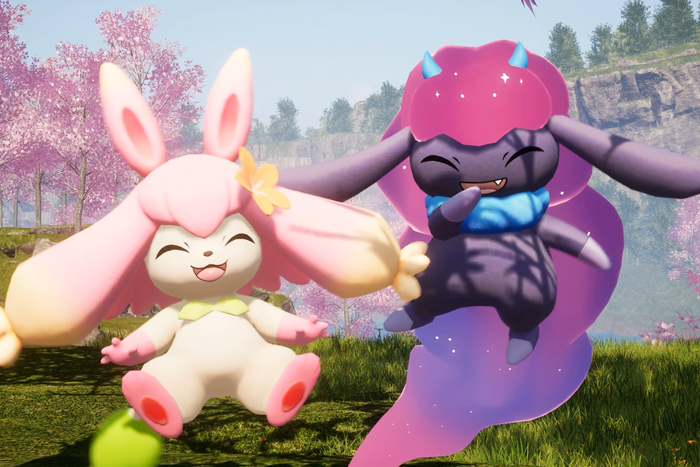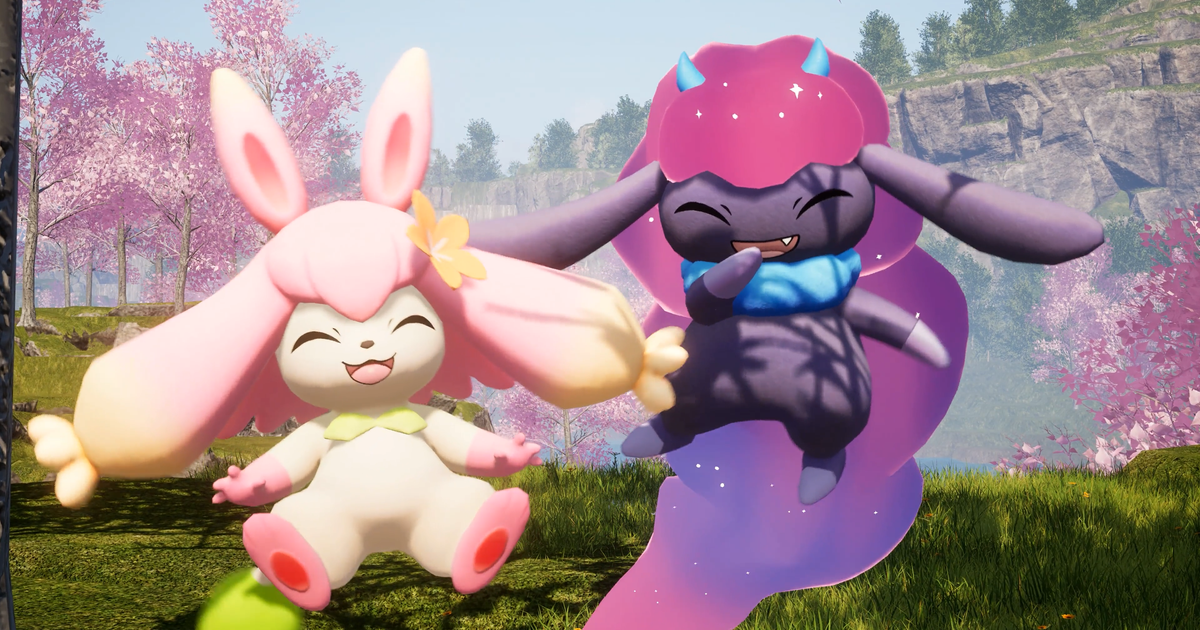
Not pictured: Submachine guns.
Photo: Pocket Pair
The opportunities for memes and violent theoreticals are abundant in Palworld, a new and somewhat controversial game colloquially referred to as “Pokémon with guns.” As glib as it is, the shorthand is broadly accurate. Made by Japanese developer Pocketpair, Palworld has you bushwhacking through a lush biome and capturing cute lil’ monsters for the purposes of collection, combat, and forced labor. (You can instruct them to build out your base, you see.) Those creatures happen to sport designs that are brazenly reminiscent of Pokémon — don’t tell me that Foxparks doesn’t look like a skinnier Eevee — and also, you can equip some of them with various firearms. Hence, “Pokémon with guns,” though it frankly takes a fair amount of time before you can trick out your little green monkey, called a Tanzee, with a double-pump shotgun.
In large part because of its strangeness, Palworld has surprisingly become among the year’s first, and loudest, blockbuster gaming successes. (Shout-out to Prince of Persia: The Lost Crown, an unexpectedly great franchise reboot that would’ve completely owned January if it weren’t for this.) Almost every write-up on Palworld leads with its mind-boggling sales data: After launching in early access last Friday, the game sold a million copies in its first eight hours, then crossed the 7 million threshold in five days. At this writing, it’s topping the Steam Charts for most concurrent players, often doubling the count of the next-most entry, Counter-Strike 2. To use a cliché, it’s having a moment: You’ll find Palworld all over Twitch, YouTube, and games coverage right now.
It’s not hard to see why. To begin with, there’s the Pokémon of it all. An ungodly number of people around the world have a strong affinity for the underlying Pokémon formula, but since the actual games themselves have been pretty bad for a while, mostly due to persistent technical issues and little design innovation, there’s a clear gap to be filled with anything resembling a clear, competent replacement. There’s also that bizarre hook of arming these creatures, called “Pals,” with guns; a twist that undoubtedly adds to Palworld’s virality in an environment where the possibility for the comically absurd is a huge factor driving a game’s popularity among livestreamers. Party Animals, a game where you commandeer floppy cute animals to beat up on other floppy cute animals with assorted weaponry, popped on Twitch and YouTube when it was released last fall. More recently, Lethal Company, ostensibly a horror game, is having a similar moment due to its capacity for putting groups of players in very tense, very funny scenarios usually resulting in their demise.
Unsurprisingly, the story of Palworld’s astronomical ascent has been shaped by controversy, at the heart of which are two overlapping accusations. The first comes out of the aforementioned “Pokémon with guns” shorthand: that Palworld is a grand work of cynical creative plagiarism. Pokémon may well be the primary target for that theft, but the copping is not exclusive to it. You know how they say “If you steal from one author it’s plagiarism, if you steal from many it’s research”? Palworld sits at the very edge of that idea, in the sense that it feels like a Frankenstein where different components of other games are taken wholesale and smashed together somewhat inelegantly. You can see Fortnite all over its aesthetic, right down to the contours of the avatar’s bodies. Its base-building mechanic sits somewhere between Minecraft and Rust. One of the very first things you experience stepping into Palworld is a “new location” sound cue straight out of Breath of the Wild. Of course, video games are a distinctly iterative medium. Consider the Metroidvania or Soulslike genres, where each noteworthy new entrant is typically defined by refining or innovating on mechanics that have come before to result in something unambiguously new. But the curious thing about Palworld is how each individual component often feels distinctly like the game it’s clearly borrowing from. That’s resulted in more than a few other game developers feeling bothered about the whole thing, as this Gamespot post illustrates, and perhaps rightly so. And as for the creature designs “inspired” by Pokémon, Pocketpair CEO Takuro Mizobe claimed in an interview with the games site Automaton that everything’s legally up to snuff — though the Pokémon Company has announced that it intends “to investigate and take appropriate measures to address any acts that infringe on intellectual property rights related to the Pokémon.”
The other accusation revolves around the question of whether Pocketpair used generative artificial intelligence to produce Palworld’s suspiciously familiar creature designs, among other assets. This prospect pokes at a nerve that’s pretty raw for many in game-development circles of late. Just as generative AI is being used as a means, and excuse, to decimate labor forces across several other industries, the same is shaking out to be especially true for a game-development world already struggling with the cost of endless corporate chicanery. That said, as Forbes notes, the evidence supporting the generative AI accusation is at this point spurious or circumstantial at best, but you can see why it’s easy to believe that Pocketpair, which seems to have taken all sorts of shortcuts to create its surprise hit, might’ve used that technology to produce its Pokémon knockoffs. In any case, Pocketpair might not have used generative AI to create Palworld, but in some deeper sense, the studio’s approach nevertheless follows the broad arc of what that technology sorta-kinda does: regurgitate wide swathes of what’s come before to produce something that ultimately feels uncanny even as it is successful within the parameters of what it’s trying to do.
None of this would necessarily matter if Palworld wasn’t actually fun as hell to jam with. It might still be in early access, but it hasn’t been true for a while that games need to be polished or even fully completed for them to be successful. So it is with Palworld, which, despite its jankiness, delivers a very satisfying gameplay loop. None of it is particularly groundbreaking: You explore, gather resources, capture little creatures with names like Depresso and Fuack, build out a base to call your own, then you do it again and again with the motivation of leveling everything up, capturing even stronger creatures, and expanding your base even further while mapping out the world. But the game is balanced in a way that feels devilishly sticky. It’s both absorbing when you want it to be and smooth-brained enough to be an excellent podcast activity; a flow-state game to play while you’re also consuming something else. Since picking it up over the weekend, I’ve unwittingly sunk 12 hours into the thing.
All of this has led to Palworld being one of the stranger gaming phenomena of late. In addition to whatever might happen on the copyright infringement front, the big question now is whether Pocketpair can convert its breakout moment into a machine built for the long run. However successful it will be in that pursuit, Palworld can probably already claim some means to a legacy. Its breakout moment carries a distinct edge of surreality, one that feels true to the surreality of a lot of things on the internet right now. Through that lens, it’s hard not to think of it as a weird bridge between the present and the future, one that may well be poised to take over the world.
